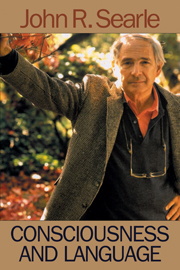Book contents
- Frontmatter
- Contents
- Introduction
- 1 The Problem of Consciousness
- 2 How to Study Consciousness Scientifically
- 3 Consciousness
- 4 Animal Minds
- 5 Intentionality and Its Place in Nature
- 6 Collective Intentions and Actions
- 7 The Explanation of Cognition
- 8 Intentionalistic Explanations in the Social Sciences
- 9 Individual Intentionality and Social Phenomena in the Theory of Speech Acts
- 10 How Performatives Work
- 11 Conversation
- 12 Analytic Philosophy and Mental Phenomena
- 13 Indeterminacy, Empiricism, and the First Person
- 14 Skepticism About Rules and Intentionality
- Name Index
- Subject Index
5 - Intentionality and Its Place in Nature
Published online by Cambridge University Press: 14 January 2010
- Frontmatter
- Contents
- Introduction
- 1 The Problem of Consciousness
- 2 How to Study Consciousness Scientifically
- 3 Consciousness
- 4 Animal Minds
- 5 Intentionality and Its Place in Nature
- 6 Collective Intentions and Actions
- 7 The Explanation of Cognition
- 8 Intentionalistic Explanations in the Social Sciences
- 9 Individual Intentionality and Social Phenomena in the Theory of Speech Acts
- 10 How Performatives Work
- 11 Conversation
- 12 Analytic Philosophy and Mental Phenomena
- 13 Indeterminacy, Empiricism, and the First Person
- 14 Skepticism About Rules and Intentionality
- Name Index
- Subject Index
Summary
Intentionality is that feature of certain mental states and events that consists in their (in a special sense of these words) being directed at, being about, being of, or representing certain other entities and states of affairs. If, for example, Robert has the belief that Ronald Reagan is president, then his belief is an intentional state because in the appropriate sense his belief is directed at, or about, or of, or represents Ronald Reagan and the state of affairs that Ronald Reagan is president. In such a case Ronald Reagan is the intentional object of Robert's belief, and the existence of the state of affairs that Ronald Reagan is president is the condition of satisfaction of his belief. If there is not anything that a belief is about, then it does not have an intentional object; and if the state of affairs it represents does not obtain, it is not satisfied.
Ascriptions of intentionality are of differing kinds, and as these differences have been a source of confusion, I will begin by sorting out some of them. Consider the statements made in utterances of the following sentences:
Robert believes that Ronald Reagan is president.
Bill sees that it is snowing.
“Es regnet” means it's raining.
My car thermostat perceives changes in the engine temperature.
Each of these statements ascribes intentionality, but the status of the ascriptions is different.
- Type
- Chapter
- Information
- Consciousness and Language , pp. 77 - 89Publisher: Cambridge University PressPrint publication year: 2002



